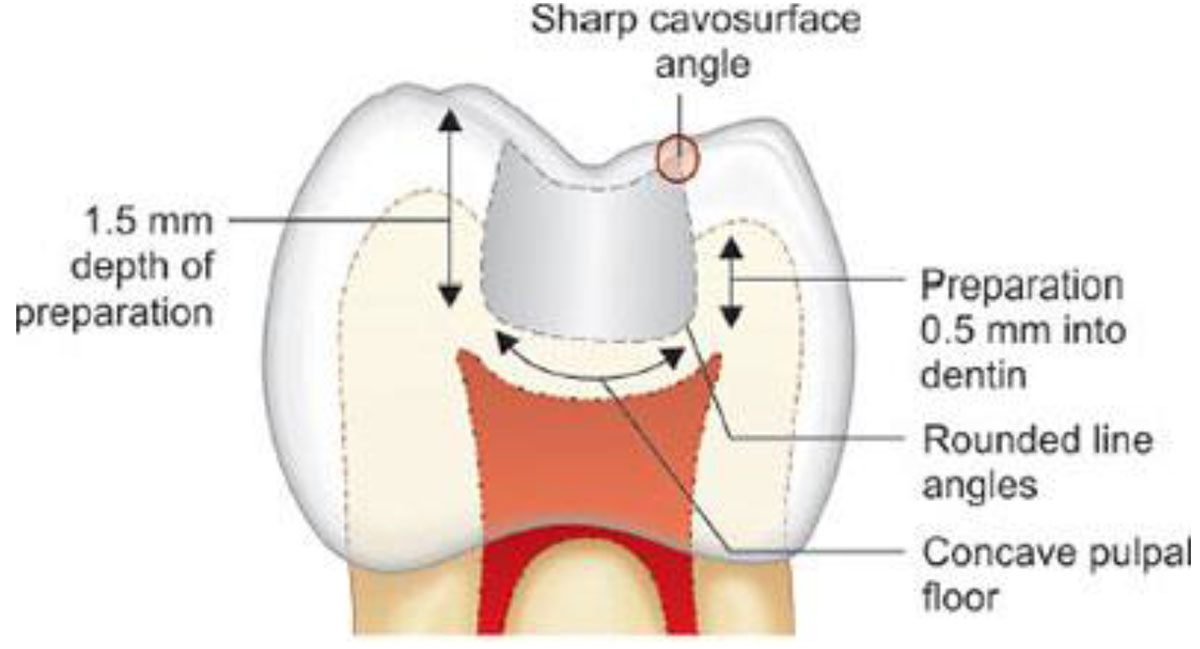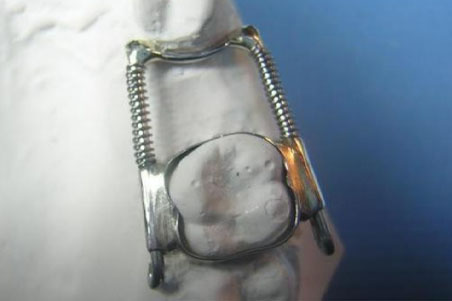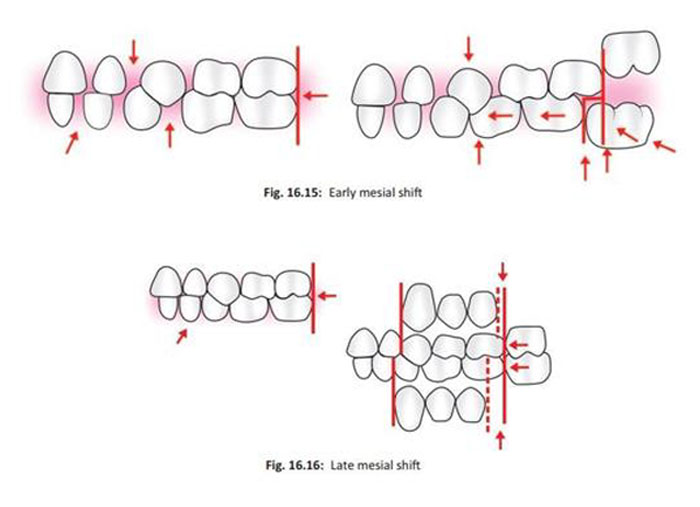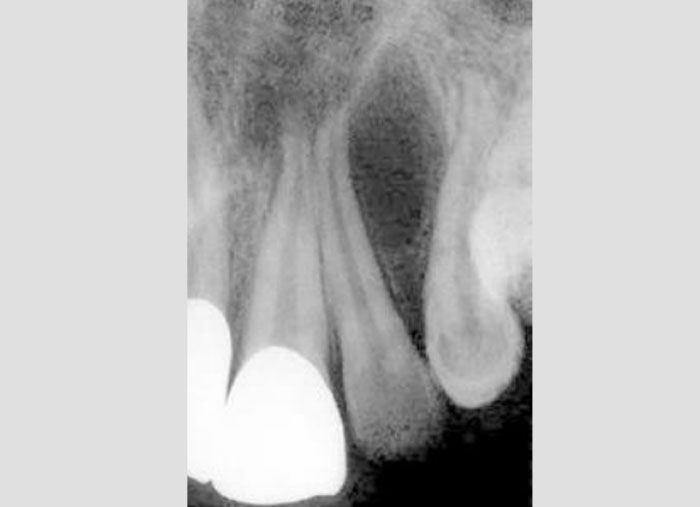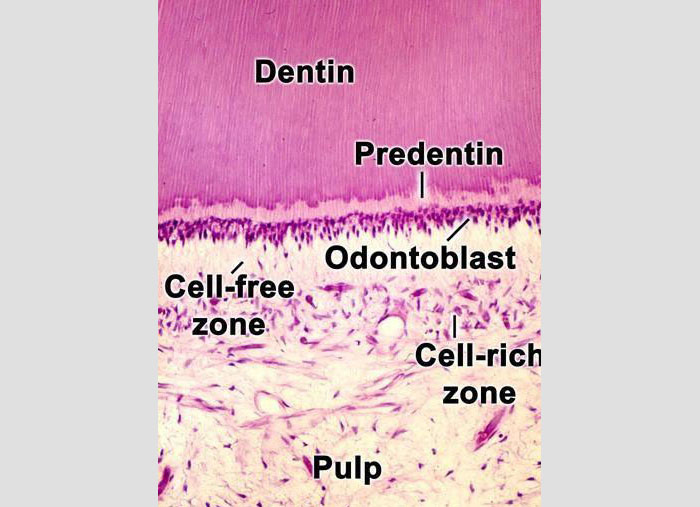- NEED HELP? CALL US NOW
- +919995411505
- thefuturedentistry@gmail.com
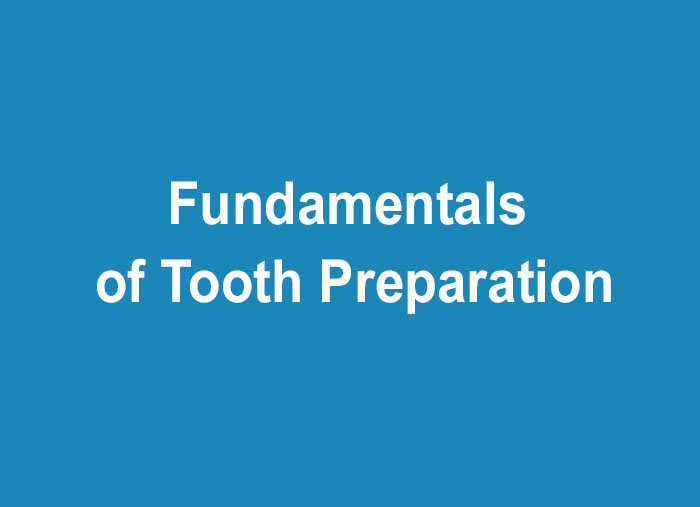
Definition of Tooth Preparation
Tooth preparation is the mechanical alteration of a defective, injured, or diseased tooth such that placement of restorative material re-establishes normal form and function, including esthetic corrections, where indicated.
Objectives of Tooth Preparation
Generally, the objectives of tooth preparation are to
- Remove all defects and provide necessary protection to the pulp,
- extend the restoration as conservatively as possible,
- Form the tooth preparation so that under the forces of mastication, the tooth or the restoration (or both) will not fracture and the restoration will not be displaced, and
- Allow for the esthetic and functional placement of a restorative material.
Tooth Preparation Walls
Internal Wall
The internal wall is the prepared surface that does not extend to the external tooth surface.
Axial Wall
The axial wall is the internal wall parallel to the long axis of the tooth
Pulpal Wall (Floor)
The pulpal wall is the internal wall that is perpendicular to the long axis of the tooth and occlusal of the pulp.
External Wall
The external wall is the prepared surface that extends to the external tooth surface. Such a wall takes the name of the tooth surface (or aspect) that the wall is adjacent to.
Floor (or Seat)
The floor (or seat) is the prepared wall that is reasonably horizontal and perpendicular to the occlusal forces that are directed occlusogingivally (generally parallel to the long axis of the tooth). Examples are pulpal and gingival floors. Such floors may be purposefully prepared to provide stabilizing seats for the restoration, distributing the stresses in the tooth structure rather than concentrating them. This preparation feature increases the resistance form of the restored tooth against post-restorative fracture.
Enamel Wall
The enamel wall is that portion of a prepared external wall consisting of enamel
Dentinal Wall
The dentinal wall is that portion of a prepared external wall consisting of dentin, in which mechanical retention features may be located
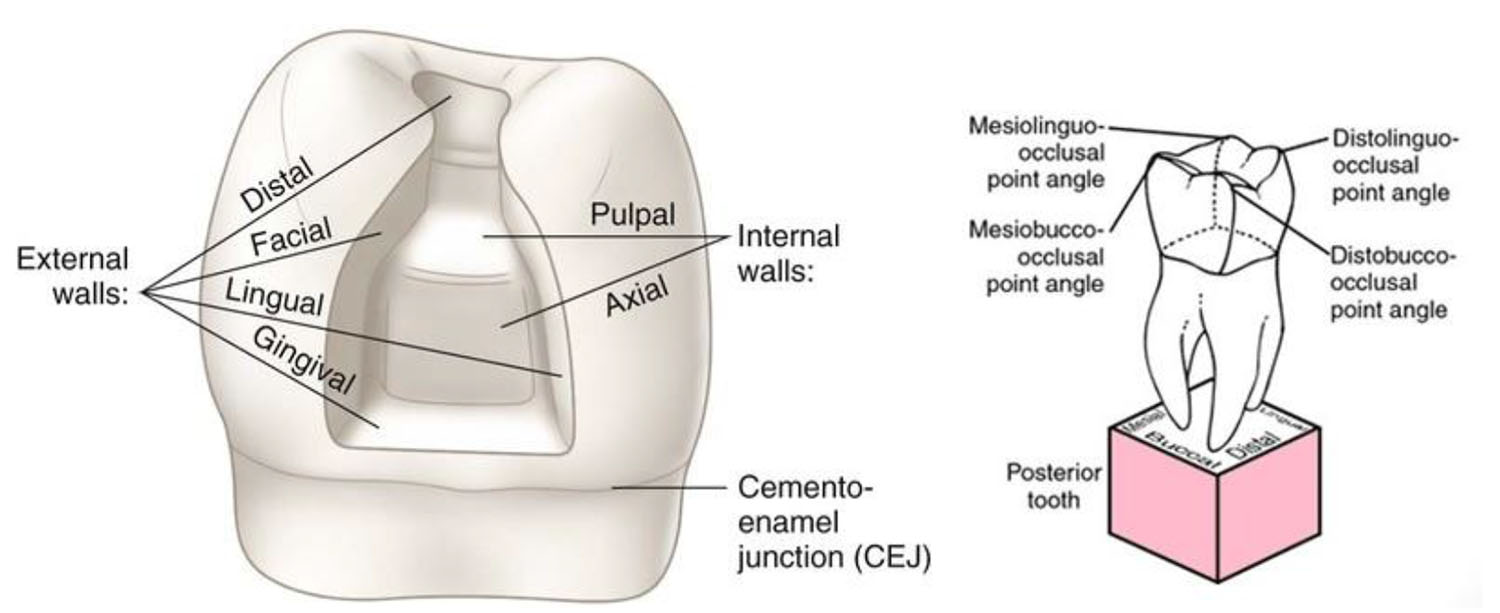
Tooth Preparation Angles
- LINE ANGLE - A line angle is the junction of two plane surfaces of different orientation along a line . An INTERNAL LINE ANGLE is a line angle whose apex points into the tooth.An EXTERNAL LINE ANGLE is a line angle whose apex points away from the tooth.
- POINT ANGLE - A point angle is the junction of three planal surfaces of different orientation.
- CAVOSURFACE ANGLE AND CAVOSUFACE MARGIN - The cavosurface angle is the angle of tooth surface formed by the junction of a prepared wall and the external surface of the tooth. The actual junction is referred to as the cavosurface margin.
| INITIAL TOOTH PREPARATION STAGE |
|---|
|
| FINAL TOOTH PREPARATION STAGE |
|
"Initial tooth preparation is the extension and initial design of the external walls of the preparation at a specified, limited depth so as to provide access to the caries or defect, reach sound tooth structure (except for later removal of infected dentin on the pulpal or axial walls), resist fracture of the tooth or restorative material from masticatory forces principally directed with the long axis of the tooth, and retain the restorative material in the tooth.‟ – Sturdevant
Outline Form and Initial Depth - Definition
Principles
- All friable and/or weakened enamel should be removed.
- All faults should be included.
- All margins should be placed in a position to afford good finishing of the margins of the restoration.
Factors controlling outline form
- Extent of carious lesion, defect or faulty old restoration.
- Esthetic considerations.
- Occlusal requirements.
- Adjacent tooth contour.
- Cavosurface marginal configuration which varies with type of restorative material used.
Features
- Preserving cuspal strength
- Preserving marginal ridge strength
- Minimizing faciolingual extension
- Using enameloplasty
- Connecting two close(less than 0.5 mm apart) faults or tooth preparations
- Restricting the depth of the preparation into dentin to a maximum of 0.2 mm for pit-and-fissure caries and 0.2 to 0.8 mm for the axial wall of smooth surface caries
Rules for establishing outline form in pit and fissure
- Extend the preparation margin until sound tooth structure is obtained and no unsupported and/or weakened enamel remains.
- Avoid terminating the margin on extreme eminences such as cusp heights or ridge crests.
- If the extension from a primary groove includes one half or more of the cusp incline, consideration should be given to capping the cusp. If the extension is two-thirds, the cusp-capping procedure is most often the proper procedure which removes the margin from the area of masticatory stresses.
- Extend the preparation margin to include all of the fissure that cannot be eliminated by appropriate enameloplasty.
- Restrict the pulpal depth of the preparation to a maximum of 0.2 mm into dentin
- When two pit-and-fissure preparations have less than 0.5 mm of sound tooth structure between them, they should be joined to eliminate a weak enamel wall between them.
- Outline form should be extended to provide sufficient access for proper tooth preparation, placement of restorations and finishing procedures.
Rule for cusp capping:
- If extension from a primary groove toward the cusp tip is no more than half the distance, then no cusp capping;
- If this extension is from one half to two thirds of the distance, then consider cusp capping;
- If the extension is more than two thirds of the distance, then usually cap the cusp.
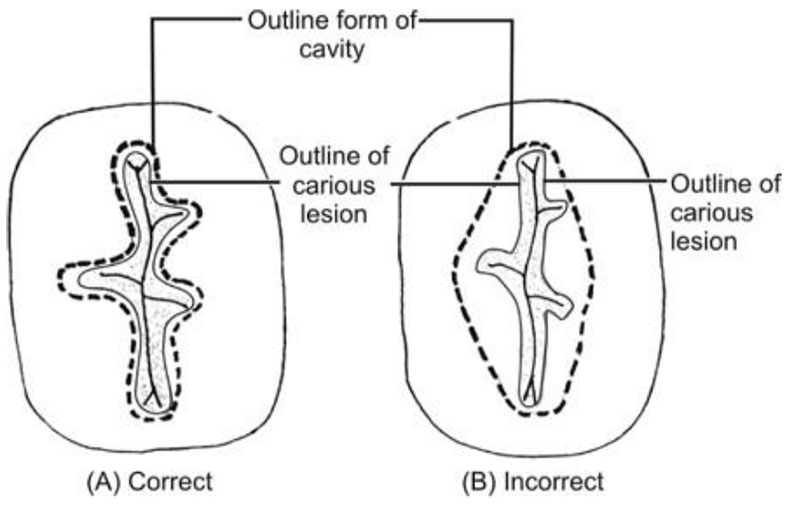
| RULES FOR ESTABLISHING OUTLINE FORMS FOR PROXIMAL SURFACE TOOTH PREPARATIONS | RULES FOR ESTABLISHING OUTLINE FORMS FOR GINGIVAL PORTION OF FACIAL AND LINGUAL SURFACES(CLASS Ⅴ) |
|---|---|
|
|
NOTE
ENAMELOPLASTY
Sometimes a pit or groove does not penetrate to any great depth into enamel and does not allow proper preparation of tooth margins except by undesirable extension.
If such a shallow feature is removed, and the convolution of the enamel is rounded or “saucered”,the area becomes cleanable and finishable and allows conservative placement of the preparation margins.
This procedure of reshaping the enamel surface with suitable rotary cutting instruments is termed ENAMELOPLASTY.
PRIMARY RESISTANCE FORM
Primary resistance form may be defined as the shape and placement of the preparation walls that best enable the restoration and the tooth to withstand, without fracture, masticatory forces delivered principally in the long axis of the tooth. (Sturdevant)
Principles
- To use the box shape with a relatively flat floor, which helps the tooth resist occlusal loading by virtue of being at right angles to the forces of mastication that are directed in the long axis of the tooth.
- To restrict the extension of the external walls to allow strong cusp and ridge areas to remain with sufficient dentin support.
- To have a slight rounding of internal line angles to reduce stress concentrations in tooth structure.
- To cap weak cusps and envelope or include enough of the weakened tooth structure within the restoration in extensive tooth preparations to prevent or resist fracture of the tooth by forces in the long axis and obliquely directed forces.
- To provide enough thickness to restorative material to prevent its fracture under load.
- To bond the material to tooth structure when appropriate.
Factors affecting resistance form
- Assessment of the occlusal contact on the restoration and remaining tooth structure.
- Amount of remaining tooth structure ( eg. In class IV restorations , the cavity is kept narrow faciolingually to obtain resistance form)
- All weakened , friable tooth structure should always be removed
- Enhancement of the resistance form by bonding the restoration to the remaining tooth.
- Type of restorative material- The minimum thickness of restorative material required for restoration with :- amalgam 1.5 mm, cast restoration 1 mm ,ceramics 2 mm; to resist fracture.
- Occlusal stresses on the tooth ( Greater the occlusal force , the greater is the potential for future fracture)
Features
- Relatively flat floor
- Box shape
- Inclusion of weakened tooth structure
- Preservation of cusps and marginal ridges
- Rounded internal line angles
- Adequate thickness of restorative material
- Reduction of cusps for capping when indicated
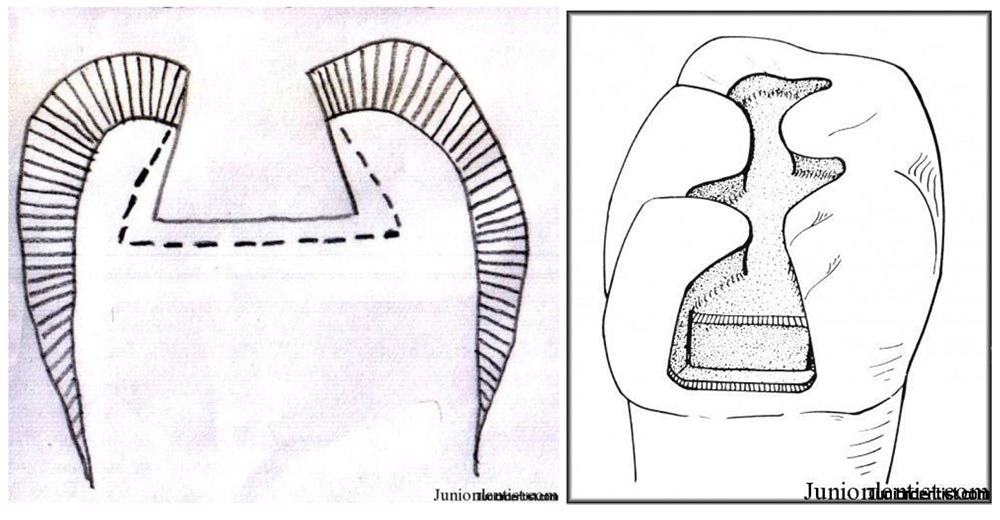
PRIMARY RETENTION FORM
Primary retention form is the shape or form of the conventional preparation that resists displacement or removal of the restoration by tipping or lifting forces. Although they are separate entities,the same prepared form may contribute to both resistance and retention qualities of the preparation. (Sturdevant)
PRINCIPLES
For Amalgam restorations
- In most class I and all class II preparations, the amalgam is retained in the tooth by developing external tooth walls that converge occlusally
- Occlusal convergence of the proximal portion helps in conserving the marginal ridges
- The cavosurface angle where the proximal facial and lingual surfaces meet the marginal ridge is a desirable 90 degrees because of the occlusal convergence of the preparation
- Adhesive systems provide some retention by micromechanically bonding amalgam to tooth structure and reducing or eliminating microleakage.
For Composite restorations
- Composite restorations are retained in the tooth by a micromechanical bond that develops between the material and the etched and primed prepared tooth surface.
- The enamel and dentin are etched by an acid ,and the dentin is primed with a dentin bonding agent before placement of the composite.
- Other conventional- type composite restorations may require a separate enamel bevelling procedure that would be done in final tooth preparation.
For Cast Metal restorations
- Close parallelism of the opposing walls, with small angle of divergence (2-5 degrees) from the line of draw , helps in enhancing retention.
- The degree of divergence needed primarily depends on the length of the prepared walls: the greater the vertical height of the walls , the more divergence is permitted , but within the range mentioned.
- In class II preparations , an occlusal dovetail may aid in preventing the tipping of the restoration by occlusal forces.
CONVENIENCE FORM
Convenience form is the shape or form of the preparation that provides for adequate observation, accessibility, and ease of operation in preparing and restoring the tooth. (Sturdevant)
FEATURES
- Obtaining this form may necessitate extension of distal, mesial, facial or lingual walls to gain adequate access to the deeper portion of the preparation.
- Occlusal divergence of vertical walls in class II cast restorations.
- Extending proximal preparations beyond proximal contacts ie. Proximal clearance of contact area
